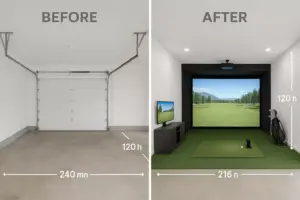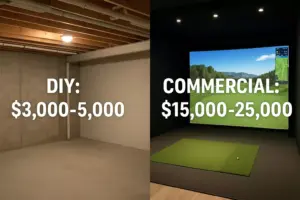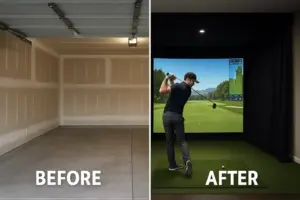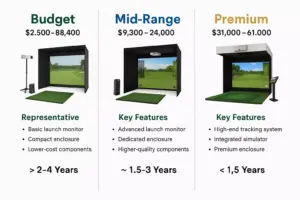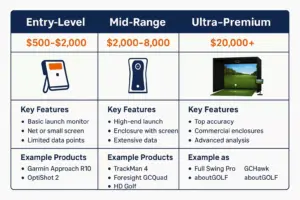5 Best Home Golf Simulators of 2025: Realistic Play Without Leaving Home
Ever dreamed of playing Pebble Beach while still in your pajamas? As we move through 2025, home golf simulators have evolved from luxury novelties to sophisticated training systems that deliver remarkably realistic experiences. Today’s technology allows golfers to practice year-round, regardless of weather conditions or daylight hours, bringing professional-level analysis and world-famous courses right into your living space.
The home golf simulator market has grown exponentially, with systems now offering stunning graphics, precise ball and club tracking, and detailed analytics that rival what tour professionals use. Whether you’re looking to shave strokes off your handicap or simply enjoy a round with friends without leaving home, there’s a simulator that fits your needs and space.
Key Takeaways

- TrackMan Home Simulator leads the market in 2025 with unmatched accuracy and professional-grade analytics.
- Budget-conscious golfers can still find quality options under $5,000 with the SkyTrak GameDay package.
- Space requirements vary significantly between systems, with some requiring as little as 8 feet of ceiling height.
- Software packages have become increasingly important, with course libraries now featuring over 200 world-famous venues.
- Integration capabilities with smartphones and wearables have become standard features in premium simulators.
How We Evaluated the Best Home Golf Simulators
Before diving into our top picks, it’s important to understand the criteria we used to evaluate these systems:
Tracking Accuracy
The heart of any golf simulator is its ability to accurately measure your swing and ball flight. We tested each system’s tracking technology for:
- Ball speed, launch angle, and spin rate accuracy
- Club path and face angle measurements
- Consistency across different clubs (from drivers to wedges)
Simulation Quality
A realistic experience depends heavily on software quality. We evaluated:
- Graphics quality and course rendering
- Physics engine realism
- Weather simulation capabilities
- Loading times and overall performance
Space Requirements
Not everyone has a dedicated room for golf. We considered:
- Minimum ceiling height needed
- Total space requirements (width and depth)
- Permanent vs. portable setup options
Software Package
The included software can make or break your experience:
- Number and quality of available courses
- Practice facilities and game modes
- Multiplayer capabilities
- Subscription costs and additional course fees
Value for Money
Golf simulators represent a significant investment, so we assessed:
- Initial purchase price
- Additional costs (screens, mats, computers)
- Warranty coverage
- Expected lifespan of technology
1. TrackMan Home Simulator: Best Overall
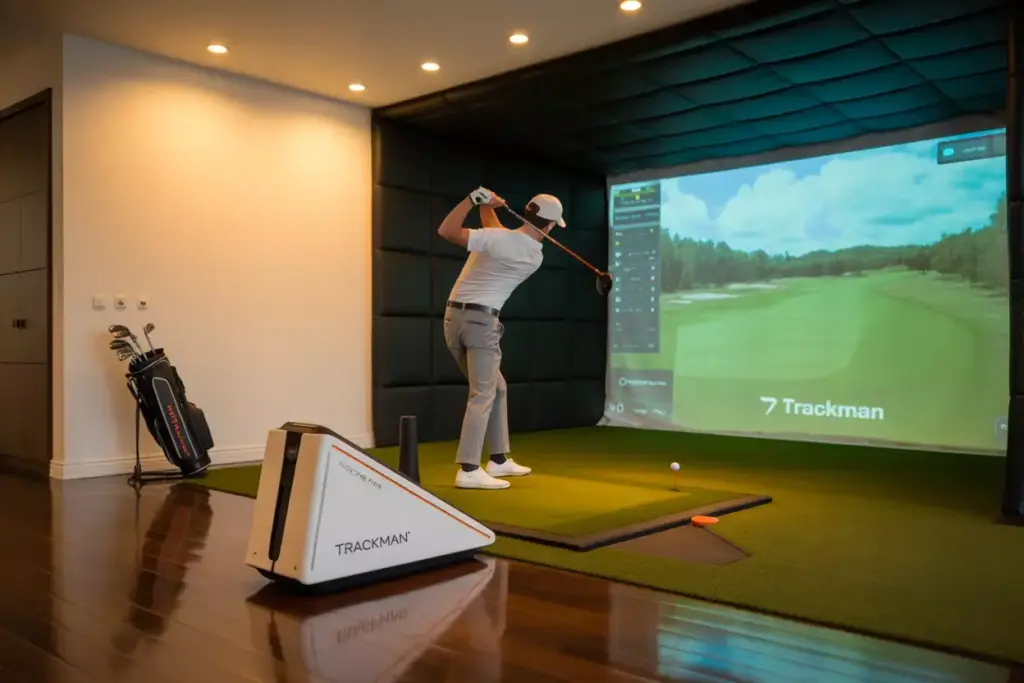
Price Range: $25,000 – $55,000
TrackMan has long been the gold standard in launch monitors for PGA Tour professionals, and their home simulator package for 2025 continues to set the bar for accuracy and features.
What We Love
TrackMan’s dual-radar technology tracks both club and ball with unprecedented precision. The system captures over 30 data points on every swing, providing insights that were once available only to tour players. The 2025 model introduces their new “TruFeel” feedback system that simulates the actual feel of different turf conditions through their responsive hitting mat.
The software package is equally impressive, featuring over 200 meticulously recreated courses in stunning 4K resolution. The latest update includes atmospheric effects that adjust ball flight based on simulated weather conditions, adding another layer of realism to your virtual rounds.
Room for Improvement
The elephant in the room is the price tag. Starting at $25,000 for the basic package and climbing above $50,000 for a fully installed premium setup, TrackMan remains an investment that many golfers simply can’t justify. Additionally, the system requires substantial space—a minimum room size of 16′ wide × 20′ deep × 10′ high is recommended for optimal performance.
Perfect For
Serious golfers with the budget and space to accommodate a professional-grade system. If you’re looking to make significant improvements to your game or want the most realistic simulation experience possible, TrackMan delivers unmatched performance.
Key Specifications
- Tracking Technology: Dual radar system (club and ball tracking)
- Accuracy: ±0.5 mph ball speed, ±0.2° launch angle
- Included Courses: 200+ (with quarterly additions)
- Space Required: 16′ × 20′ × 10′ (minimum)
- Software Subscription: First year included, then $1,200/year
2. SkyTrak GameDay Package: Best Value

Price Range: $3,999 – $7,999
The SkyTrak system has been refined over years to offer the best balance of accuracy and affordability, making it our top value pick for 2025.
What We Love
SkyTrak’s photometric launch monitor technology has been upgraded in 2025 with their new “SpinTrak” feature, which significantly improves spin rate measurements—a previous weakness in their system. While not quite matching TrackMan’s precision, it provides more than enough accuracy for most golfers at a fraction of the price.
The GameDay software package now includes 100+ courses and has added impressive multiplayer features, including online tournaments and leagues. The system’s compact size also means it can fit in spaces where other simulators simply won’t work.
Room for Improvement
Despite improvements, SkyTrak still occasionally struggles with left-handed players and extreme mishits. The graphics, while good, don’t quite match the photorealistic quality of premium systems. Loading times between holes can also be noticeable compared to higher-end options.
Perfect For
Golfers seeking a balance of performance and value. The SkyTrak GameDay package delivers 90% of what premium systems offer at about 20% of the cost, making it ideal for dedicated amateurs who want quality practice without breaking the bank.
Key Specifications
- Tracking Technology: High-speed photometric
- Accuracy: ±1.5 mph ball speed, ±1.0° launch angle
- Included Courses: 100+ (additional courses available for purchase)
- Space Required: 10′ × 12′ × 8.5′ (minimum)
- Software Subscription: $199/year after first year
3. Foresight Sports GC3 SweetSpot: Best Premium Compact System

Price Range: $9,000 – $15,000
Foresight’s GC3 SweetSpot package represents the perfect middle ground between ultra-premium systems and budget options.
What We Love
The GC3’s triple camera system provides exceptional accuracy in a surprisingly compact device. The 2025 model adds a new infrared sensor array that improves club path measurements, addressing one of the few weaknesses in previous iterations.
The SweetSpot software package is truly impressive, featuring Foresight’s proprietary course-scanning technology that creates the most accurate recreations of famous courses we’ve seen. The putting simulation—often a weak point in home systems—feels remarkably true-to-life thanks to their “GreenRead” technology that accurately models break and speed.
Room for Improvement
The initial setup process remains more complex than we’d like, often requiring professional installation for optimal results. While the space requirements are reasonable, the system performs best with dedicated impact screens rather than nets, which adds to the overall footprint and cost.
Perfect For
Golfers with moderate space who don’t want to compromise on accuracy. The GC3 SweetSpot hits the sweet spot (pun intended) between premium performance and practical considerations for home use.
Key Specifications
- Tracking Technology: Triple high-speed camera with infrared
- Accuracy: ±0.8 mph ball speed, ±0.5° launch angle
- Included Courses: 150+ with ultra-realistic scanning
- Space Required: 12′ × 15′ × 9′ (recommended)
- Software Subscription: $600/year after first year
4. Garmin Approach R10 Plus: Best Portable Option

Price Range: $1,999 – $3,499
Garmin has made impressive strides with their Approach series, and the 2025 R10 Plus model delivers remarkable performance in an incredibly portable package.
What We Love
The R10 Plus weighs just under a pound and sets up in minutes, making it the ultimate portable simulator. Despite its size, it uses a combination of radar and visual tracking to capture 12 key data points with surprising accuracy. The 2025 model adds club tracking capabilities—a significant improvement over previous versions that only tracked the ball.
The Home Tee Hero software package has been completely overhauled with cartoon-style graphics that prioritize performance over photorealism, resulting in smooth gameplay even on modest computers or tablets. The R10 Plus also features the best mobile integration, with a companion app that stores your stats in the cloud and provides AI-powered swing tips.
Room for Improvement
The radar-based technology still struggles somewhat with extreme slice or hook shots, occasionally missing data points. The cartoon-style graphics, while performance-friendly, won’t satisfy golfers looking for photorealistic course renderings. The putting simulation remains simplified compared to premium systems.
Perfect For
Golfers who value flexibility and portability. The R10 Plus is ideal for those who want to practice in different locations or who don’t have dedicated space for a permanent setup. It’s also perfect as a secondary system for traveling.
Key Specifications
- Tracking Technology: Radar with visual confirmation
- Accuracy: ±2 mph ball speed, ±1.5° launch angle
- Included Courses: 50+ (simplified rendering)
- Space Required: 8′ × 10′ × 8′ (minimum)
- Software Subscription: $99/year after first year
5. Full Swing KIT: Best for Social Golfers
Price Range: $5,999 – $12,999
Full Swing has leveraged their partnership with Tiger Woods to create a system that excels at making virtual golf a social experience.
What We Love
The Full Swing KIT combines radar and camera tracking in a sleek unit that provides excellent accuracy for both ball and club data. What truly sets it apart is the “MultiFlight” feature introduced in 2025, which allows up to four players to hit shots simultaneously from different locations, with the system intelligently tracking each ball.
The software package includes the best multiplayer modes we’ve seen, including team scrambles, skins games, and even virtual pro-am tournaments where you can play alongside AI versions of famous golfers. The “Virtual Clubhouse” social features allow you to connect with friends remotely for rounds or competitions.
Room for Improvement
The system requires more lateral space than most competitors to accommodate the MultiFlight feature. Course selection, while growing, still lags behind TrackMan and Foresight. The analytics, while comprehensive, aren’t presented as clearly as they could be, making it less ideal for serious technical practice.
Perfect For
Social golfers who want to play with friends, either in person or remotely. If you view golf as primarily a social activity rather than serious practice, the Full Swing KIT offers unmatched multiplayer capabilities.
Key Specifications
- Tracking Technology: Combined radar and optical
- Accuracy: ±1.0 mph ball speed, ±0.8° launch angle
- Included Courses: 80+ (emphasis on famous tournament venues)
- Space Required: 20′ × 15′ × 9′ (for optimal MultiFlight use)
- Software Subscription: $500/year after first year
Comparison Table: 2025’s Best Home Golf Simulators
| Simulator | Price Range | Tracking Technology | Accuracy (Ball Speed) | Included Courses | Min. Space Required | Best For |
|---|---|---|---|---|---|---|
| TrackMan Home | $25,000-$55,000 | Dual radar | ±0.5 mph | 200+ | 16′ × 20′ × 10′ | Serious players seeking pro-level analysis |
| SkyTrak GameDay | $3,999-$7,999 | Photometric | ±1.5 mph | 100+ | 10′ × 12′ × 8.5′ | Best overall value |
| Foresight GC3 SweetSpot | $9,000-$15,000 | Triple camera + IR | ±0.8 mph | 150+ | 12′ × 15′ × 9′ | Premium performance in moderate space |
| Garmin Approach R10 Plus | $1,999-$3,499 | Radar + visual | ±2 mph | 50+ | 8′ × 10′ × 8′ | Portability and flexibility |
| Full Swing KIT | $5,999-$12,999 | Radar + optical | ±1.0 mph | 80+ | 20′ × 15′ × 9′ | Social and multiplayer focus |
Space Considerations for Home Golf Simulators
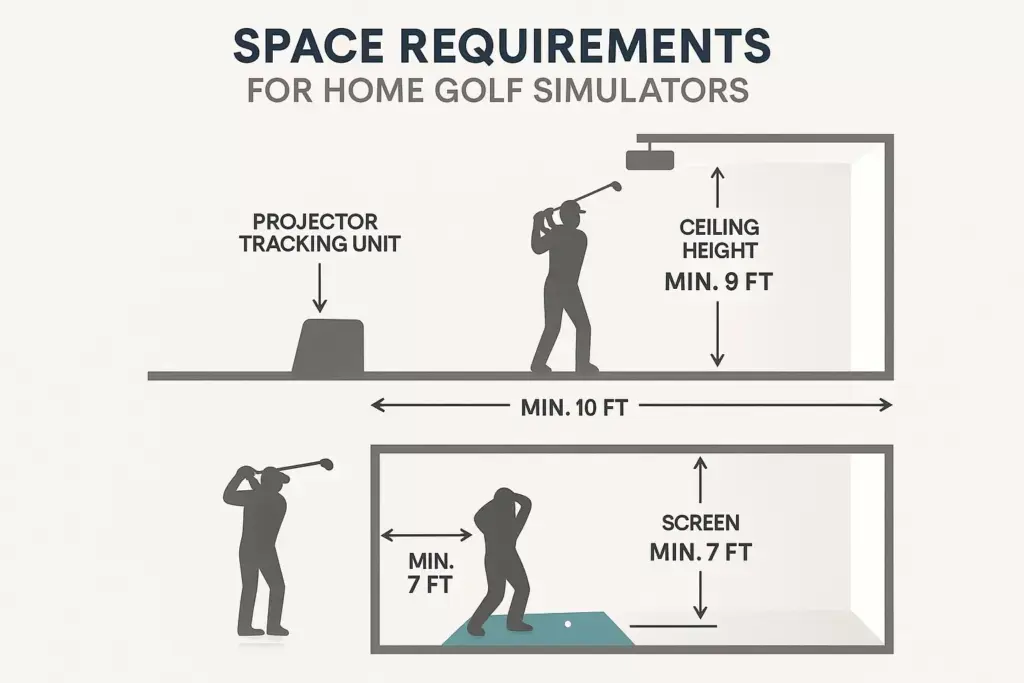
Before investing in any simulator, it’s crucial to ensure you have adequate space. Here’s what to consider:
Ceiling Height
This is often the most limiting factor in home installations. For a comfortable full swing with a driver:
- Minimum recommended: 8.5 feet
- Comfortable: 9-10 feet
- Ideal: 10+ feet
Golfers over 6 feet tall should add at least 6 inches to these recommendations.
Width and Depth
Width requirements depend on whether you’re right or left-handed (or have players of both):
- Minimum width: 10 feet (single-handed players)
- Recommended width: 15 feet (accommodates both right and left-handed players)
Depth affects how realistic your ball flight feels before hitting the screen:
- Minimum depth: 12 feet (from hitting position to screen)
- Recommended depth: 15-20 feet
Additional Space Considerations
Remember to account for:
- Space behind the hitting area (2-3 feet minimum)
- Room for computer/console setup
- Ventilation (simulators generate heat during extended use)
- Sound insulation (for apartment dwellers)
Key Features to Look For in 2025
The technology behind home golf simulators continues to evolve rapidly. Here are the latest features to consider:
Advanced Ball and Club Tracking
The most significant advances in 2025 have been in tracking technology:
- Dual tracking systems that measure both ball and club data
- AI-enhanced spin calculation for more accurate simulation
- Club face and path analytics that were once only available in professional systems
Realistic Course Rendering
Graphics capabilities have made tremendous leaps:
- Photogrammetry scanning of real courses for true-to-life recreation
- Dynamic lighting and shadow effects that change with time of day
- Realistic weather simulation that affects ball flight
Integration Capabilities
Modern simulators are no longer standalone systems:
- Smartphone app connectivity for stats tracking and remote control
- Wearable device integration (particularly with golf-specific wearables)
- Cloud storage of swing data for long-term analysis
- Video recording synchronization for swing analysis
Software Subscription Value
Most systems now operate on subscription models:
- Regular course additions (typically 5-10 new courses per year)
- Software updates with new features and improvements
- Online tournament access for competitive play
- Instruction content from teaching professionals
Installation Considerations
DIY vs. Professional Installation
While budget systems like the Garmin R10 Plus are designed for DIY setup, premium systems often benefit from professional installation:
- DIY Installation: Save $1,000-$3,000 but requires technical knowledge
- Professional Installation: Ensures optimal performance and can include custom room modifications
Essential Accessories
Beyond the simulator itself, consider these accessories:
- Premium hitting mats ($300-$1,000) that reduce injury risk and provide realistic feedback
- High-quality impact screens ($500-$2,000) for durability and image clarity
- Proper lighting ($200-$500) to eliminate shadows and improve tracking
- Sound insulation ($300-$1,500) for apartment dwellers or attached homes
Computer Requirements
Most systems require a dedicated computer or tablet:
- Budget systems: Modern tablet or mid-range gaming laptop
- Mid-range systems: Gaming laptop with dedicated GPU
- Premium systems: High-end gaming PC with latest GPU technology
Maintenance and Longevity
Keeping Your Simulator in Top Condition
To maximize your investment:
- Clean lenses/sensors monthly using manufacturer-approved methods
- Replace impact screens every 2-5 years depending on usage
- Update software regularly for bug fixes and improvements
- Replace hitting mats every 3-4 years as they compress and harden
Technology Lifespan
Consider how long your system will remain current:
- Budget systems: Typically 3-5 years before significant technology leaps
- Mid-range systems: 5-7 years of relevance
- Premium systems: 7-10 years with regular software updates
Most manufacturers now offer technology upgrade programs that allow you to trade in components rather than replacing entire systems.
Conclusion: Finding Your Perfect Home Simulator
The home golf simulator market in 2025 offers options for virtually every space and budget. When making your decision, prioritize these factors:
- Available space – Be realistic about your room dimensions
- Budget – Consider both upfront costs and ongoing subscriptions
- Primary use case – Serious practice vs. entertainment
- Installation capabilities – DIY comfort level vs. professional installation needs
For most golfers, the SkyTrak GameDay package represents the best balance of performance and value, delivering impressive accuracy and features at a price point that won’t require a second mortgage. Those with larger budgets will appreciate the unmatched precision of the TrackMan system, while space-constrained users will find the Garmin R10 Plus offers remarkable flexibility.
Whichever system you choose, today’s home simulators deliver an experience that was unimaginable just a few years ago. The ability to play world-famous courses, receive detailed swing analytics, and improve your game regardless of weather or time constraints has truly transformed how we experience golf.
The next step? Measure your space, establish your budget, and consider arranging a demo with local retailers who carry these systems. Most major golf retailers now offer simulator testing areas where you can experience these systems firsthand before making your investment.
Golf Simulator Space Calculator
Check if your room is suitable for a home golf simulator

